Personal Development Report: Conflict Resolution in Banking
VerifiedAdded on 2020/03/13
|10
|2400
|78
Report
AI Summary
This report focuses on the importance of conflict resolution as a crucial problem-solving skill for personal development, especially within the banking sector. It explores how conflict resolution helps in creating a positive and healthy working environment, fostering effective communication among employees, managers, and customers. The report emphasizes the significance of identifying the source of conflicts, practicing patience, and looking beyond the immediate issues to resolve them effectively. It highlights the impact of conflict resolution on improving service quality, enhancing customer satisfaction, and gaining a competitive advantage for the banking organization. The author, a banking manager, reflects on their personal approach to conflict resolution, emphasizing the use of accommodating strategies and the importance of a friendly and positive attitude. The report concludes with a call for continuous improvement in conflict resolution techniques, advocating for greater flexibility and openness to employee ideas.
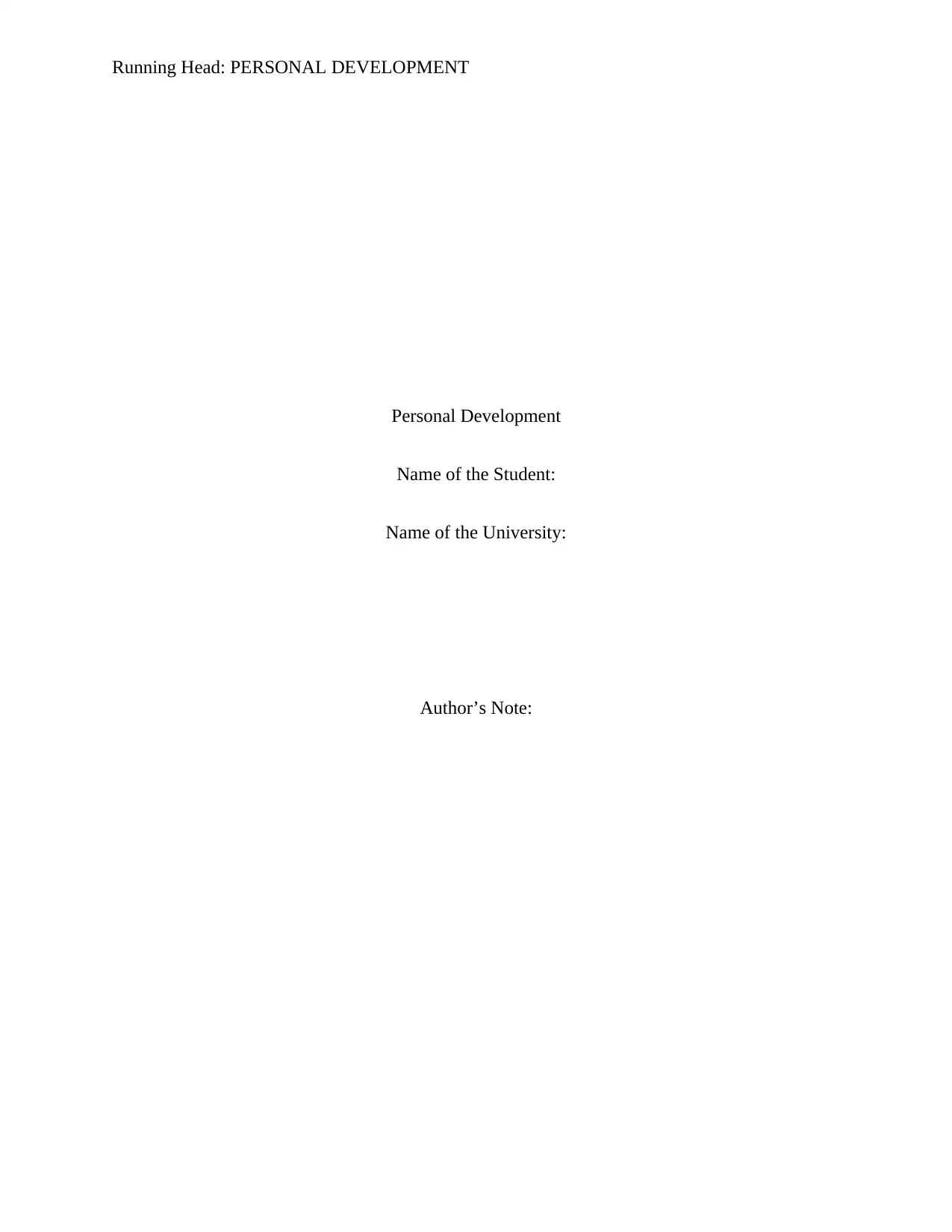
Running Head: PERSONAL DEVELOPMENT
Personal Development
Name of the Student:
Name of the University:
Author’s Note:
Personal Development
Name of the Student:
Name of the University:
Author’s Note:
Paraphrase This Document
Need a fresh take? Get an instant paraphrase of this document with our AI Paraphraser
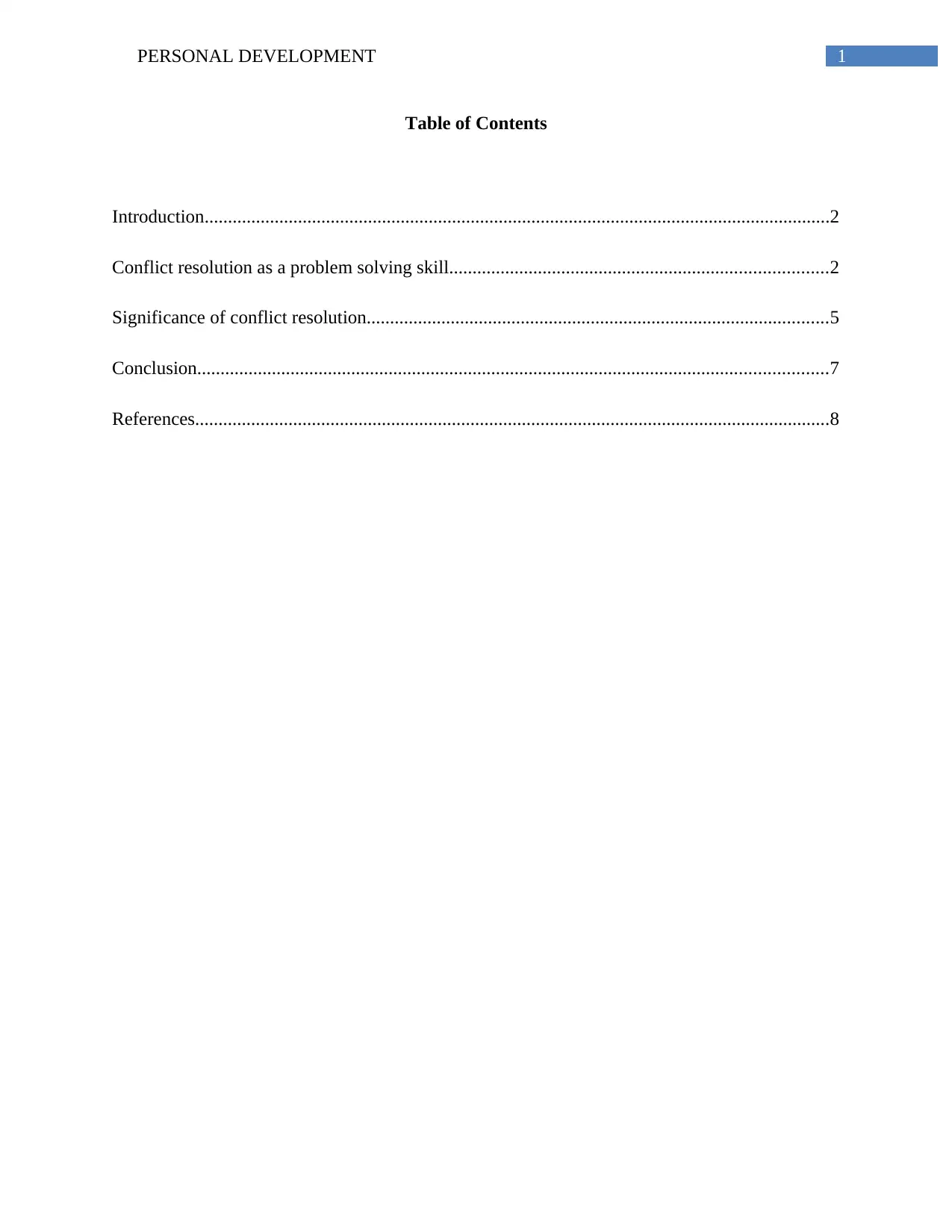
1PERSONAL DEVELOPMENT
Table of Contents
Introduction......................................................................................................................................2
Conflict resolution as a problem solving skill.................................................................................2
Significance of conflict resolution...................................................................................................5
Conclusion.......................................................................................................................................7
References........................................................................................................................................8
Table of Contents
Introduction......................................................................................................................................2
Conflict resolution as a problem solving skill.................................................................................2
Significance of conflict resolution...................................................................................................5
Conclusion.......................................................................................................................................7
References........................................................................................................................................8
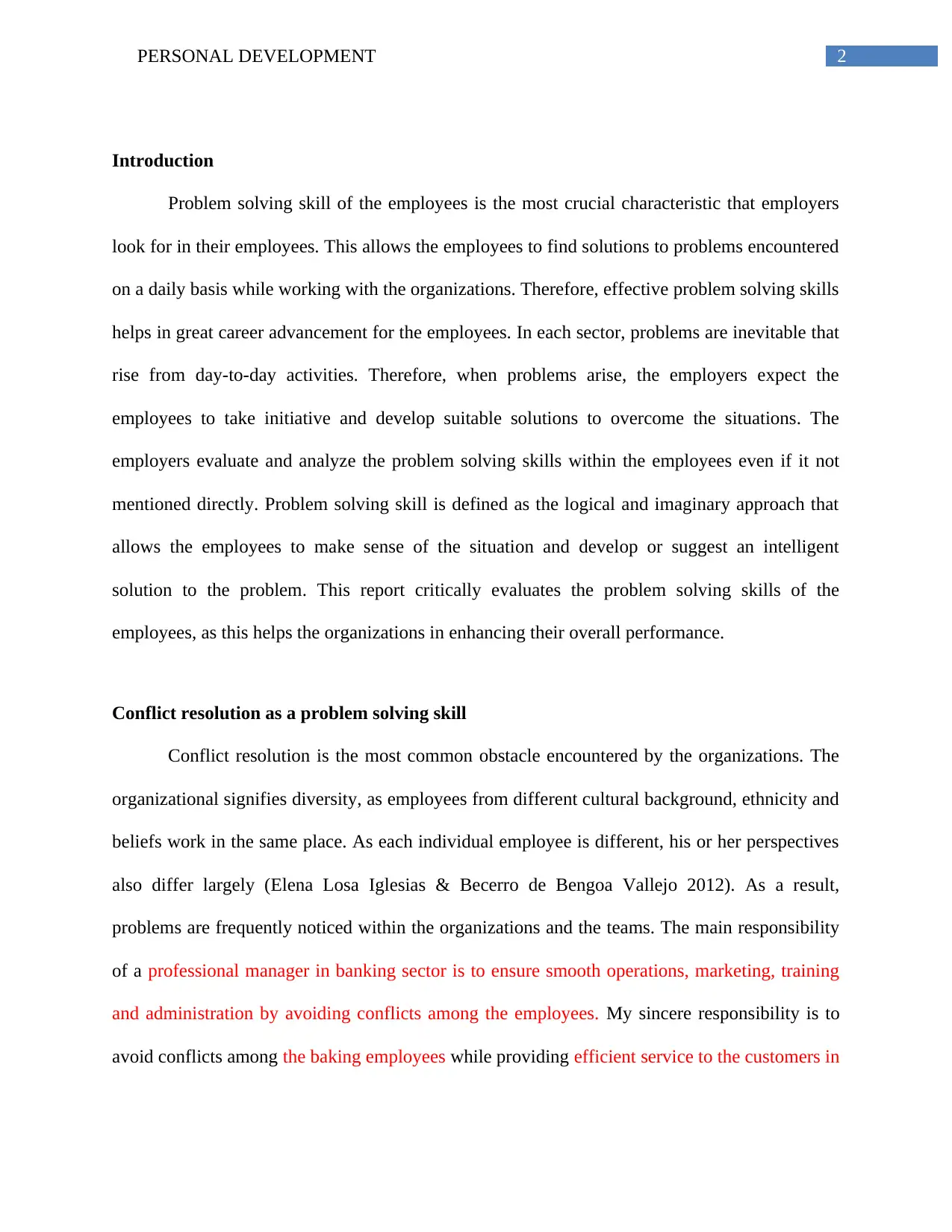
2PERSONAL DEVELOPMENT
Introduction
Problem solving skill of the employees is the most crucial characteristic that employers
look for in their employees. This allows the employees to find solutions to problems encountered
on a daily basis while working with the organizations. Therefore, effective problem solving skills
helps in great career advancement for the employees. In each sector, problems are inevitable that
rise from day-to-day activities. Therefore, when problems arise, the employers expect the
employees to take initiative and develop suitable solutions to overcome the situations. The
employers evaluate and analyze the problem solving skills within the employees even if it not
mentioned directly. Problem solving skill is defined as the logical and imaginary approach that
allows the employees to make sense of the situation and develop or suggest an intelligent
solution to the problem. This report critically evaluates the problem solving skills of the
employees, as this helps the organizations in enhancing their overall performance.
Conflict resolution as a problem solving skill
Conflict resolution is the most common obstacle encountered by the organizations. The
organizational signifies diversity, as employees from different cultural background, ethnicity and
beliefs work in the same place. As each individual employee is different, his or her perspectives
also differ largely (Elena Losa Iglesias & Becerro de Bengoa Vallejo 2012). As a result,
problems are frequently noticed within the organizations and the teams. The main responsibility
of a professional manager in banking sector is to ensure smooth operations, marketing, training
and administration by avoiding conflicts among the employees. My sincere responsibility is to
avoid conflicts among the baking employees while providing efficient service to the customers in
Introduction
Problem solving skill of the employees is the most crucial characteristic that employers
look for in their employees. This allows the employees to find solutions to problems encountered
on a daily basis while working with the organizations. Therefore, effective problem solving skills
helps in great career advancement for the employees. In each sector, problems are inevitable that
rise from day-to-day activities. Therefore, when problems arise, the employers expect the
employees to take initiative and develop suitable solutions to overcome the situations. The
employers evaluate and analyze the problem solving skills within the employees even if it not
mentioned directly. Problem solving skill is defined as the logical and imaginary approach that
allows the employees to make sense of the situation and develop or suggest an intelligent
solution to the problem. This report critically evaluates the problem solving skills of the
employees, as this helps the organizations in enhancing their overall performance.
Conflict resolution as a problem solving skill
Conflict resolution is the most common obstacle encountered by the organizations. The
organizational signifies diversity, as employees from different cultural background, ethnicity and
beliefs work in the same place. As each individual employee is different, his or her perspectives
also differ largely (Elena Losa Iglesias & Becerro de Bengoa Vallejo 2012). As a result,
problems are frequently noticed within the organizations and the teams. The main responsibility
of a professional manager in banking sector is to ensure smooth operations, marketing, training
and administration by avoiding conflicts among the employees. My sincere responsibility is to
avoid conflicts among the baking employees while providing efficient service to the customers in
⊘ This is a preview!⊘
Do you want full access?
Subscribe today to unlock all pages.

Trusted by 1+ million students worldwide
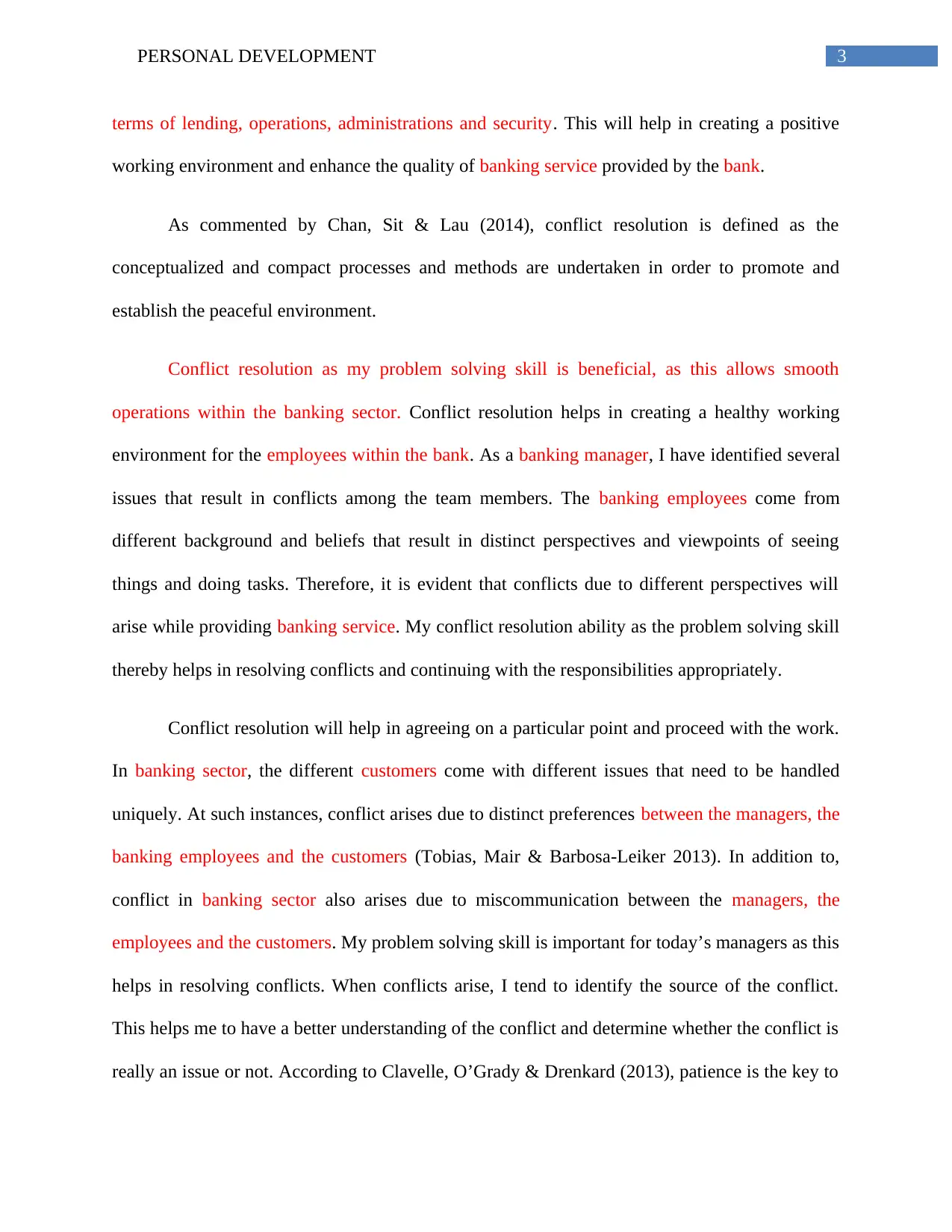
3PERSONAL DEVELOPMENT
terms of lending, operations, administrations and security. This will help in creating a positive
working environment and enhance the quality of banking service provided by the bank.
As commented by Chan, Sit & Lau (2014), conflict resolution is defined as the
conceptualized and compact processes and methods are undertaken in order to promote and
establish the peaceful environment.
Conflict resolution as my problem solving skill is beneficial, as this allows smooth
operations within the banking sector. Conflict resolution helps in creating a healthy working
environment for the employees within the bank. As a banking manager, I have identified several
issues that result in conflicts among the team members. The banking employees come from
different background and beliefs that result in distinct perspectives and viewpoints of seeing
things and doing tasks. Therefore, it is evident that conflicts due to different perspectives will
arise while providing banking service. My conflict resolution ability as the problem solving skill
thereby helps in resolving conflicts and continuing with the responsibilities appropriately.
Conflict resolution will help in agreeing on a particular point and proceed with the work.
In banking sector, the different customers come with different issues that need to be handled
uniquely. At such instances, conflict arises due to distinct preferences between the managers, the
banking employees and the customers (Tobias, Mair & Barbosa-Leiker 2013). In addition to,
conflict in banking sector also arises due to miscommunication between the managers, the
employees and the customers. My problem solving skill is important for today’s managers as this
helps in resolving conflicts. When conflicts arise, I tend to identify the source of the conflict.
This helps me to have a better understanding of the conflict and determine whether the conflict is
really an issue or not. According to Clavelle, O’Grady & Drenkard (2013), patience is the key to
terms of lending, operations, administrations and security. This will help in creating a positive
working environment and enhance the quality of banking service provided by the bank.
As commented by Chan, Sit & Lau (2014), conflict resolution is defined as the
conceptualized and compact processes and methods are undertaken in order to promote and
establish the peaceful environment.
Conflict resolution as my problem solving skill is beneficial, as this allows smooth
operations within the banking sector. Conflict resolution helps in creating a healthy working
environment for the employees within the bank. As a banking manager, I have identified several
issues that result in conflicts among the team members. The banking employees come from
different background and beliefs that result in distinct perspectives and viewpoints of seeing
things and doing tasks. Therefore, it is evident that conflicts due to different perspectives will
arise while providing banking service. My conflict resolution ability as the problem solving skill
thereby helps in resolving conflicts and continuing with the responsibilities appropriately.
Conflict resolution will help in agreeing on a particular point and proceed with the work.
In banking sector, the different customers come with different issues that need to be handled
uniquely. At such instances, conflict arises due to distinct preferences between the managers, the
banking employees and the customers (Tobias, Mair & Barbosa-Leiker 2013). In addition to,
conflict in banking sector also arises due to miscommunication between the managers, the
employees and the customers. My problem solving skill is important for today’s managers as this
helps in resolving conflicts. When conflicts arise, I tend to identify the source of the conflict.
This helps me to have a better understanding of the conflict and determine whether the conflict is
really an issue or not. According to Clavelle, O’Grady & Drenkard (2013), patience is the key to
Paraphrase This Document
Need a fresh take? Get an instant paraphrase of this document with our AI Paraphraser
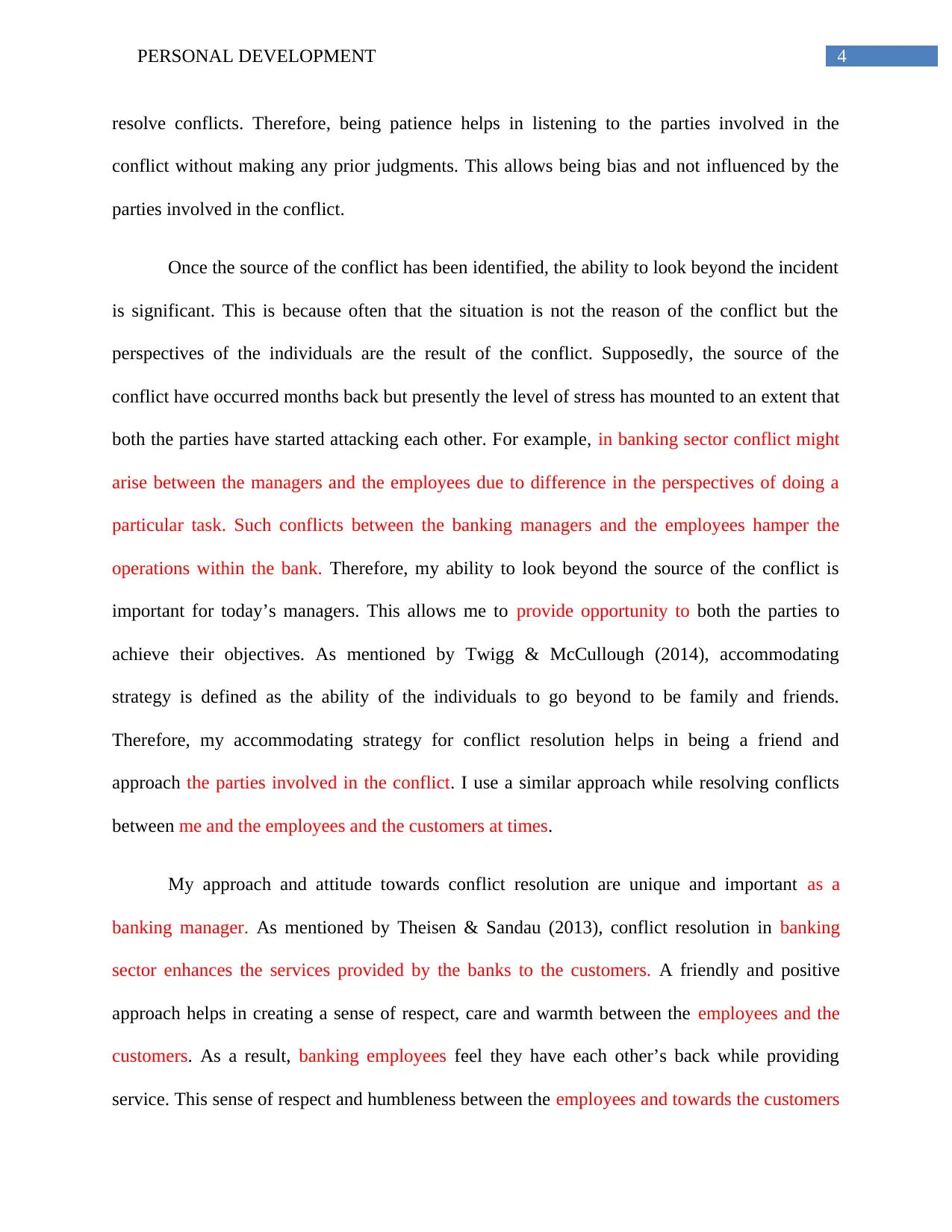
4PERSONAL DEVELOPMENT
resolve conflicts. Therefore, being patience helps in listening to the parties involved in the
conflict without making any prior judgments. This allows being bias and not influenced by the
parties involved in the conflict.
Once the source of the conflict has been identified, the ability to look beyond the incident
is significant. This is because often that the situation is not the reason of the conflict but the
perspectives of the individuals are the result of the conflict. Supposedly, the source of the
conflict have occurred months back but presently the level of stress has mounted to an extent that
both the parties have started attacking each other. For example, in banking sector conflict might
arise between the managers and the employees due to difference in the perspectives of doing a
particular task. Such conflicts between the banking managers and the employees hamper the
operations within the bank. Therefore, my ability to look beyond the source of the conflict is
important for today’s managers. This allows me to provide opportunity to both the parties to
achieve their objectives. As mentioned by Twigg & McCullough (2014), accommodating
strategy is defined as the ability of the individuals to go beyond to be family and friends.
Therefore, my accommodating strategy for conflict resolution helps in being a friend and
approach the parties involved in the conflict. I use a similar approach while resolving conflicts
between me and the employees and the customers at times.
My approach and attitude towards conflict resolution are unique and important as a
banking manager. As mentioned by Theisen & Sandau (2013), conflict resolution in banking
sector enhances the services provided by the banks to the customers. A friendly and positive
approach helps in creating a sense of respect, care and warmth between the employees and the
customers. As a result, banking employees feel they have each other’s back while providing
service. This sense of respect and humbleness between the employees and towards the customers
resolve conflicts. Therefore, being patience helps in listening to the parties involved in the
conflict without making any prior judgments. This allows being bias and not influenced by the
parties involved in the conflict.
Once the source of the conflict has been identified, the ability to look beyond the incident
is significant. This is because often that the situation is not the reason of the conflict but the
perspectives of the individuals are the result of the conflict. Supposedly, the source of the
conflict have occurred months back but presently the level of stress has mounted to an extent that
both the parties have started attacking each other. For example, in banking sector conflict might
arise between the managers and the employees due to difference in the perspectives of doing a
particular task. Such conflicts between the banking managers and the employees hamper the
operations within the bank. Therefore, my ability to look beyond the source of the conflict is
important for today’s managers. This allows me to provide opportunity to both the parties to
achieve their objectives. As mentioned by Twigg & McCullough (2014), accommodating
strategy is defined as the ability of the individuals to go beyond to be family and friends.
Therefore, my accommodating strategy for conflict resolution helps in being a friend and
approach the parties involved in the conflict. I use a similar approach while resolving conflicts
between me and the employees and the customers at times.
My approach and attitude towards conflict resolution are unique and important as a
banking manager. As mentioned by Theisen & Sandau (2013), conflict resolution in banking
sector enhances the services provided by the banks to the customers. A friendly and positive
approach helps in creating a sense of respect, care and warmth between the employees and the
customers. As a result, banking employees feel they have each other’s back while providing
service. This sense of respect and humbleness between the employees and towards the customers
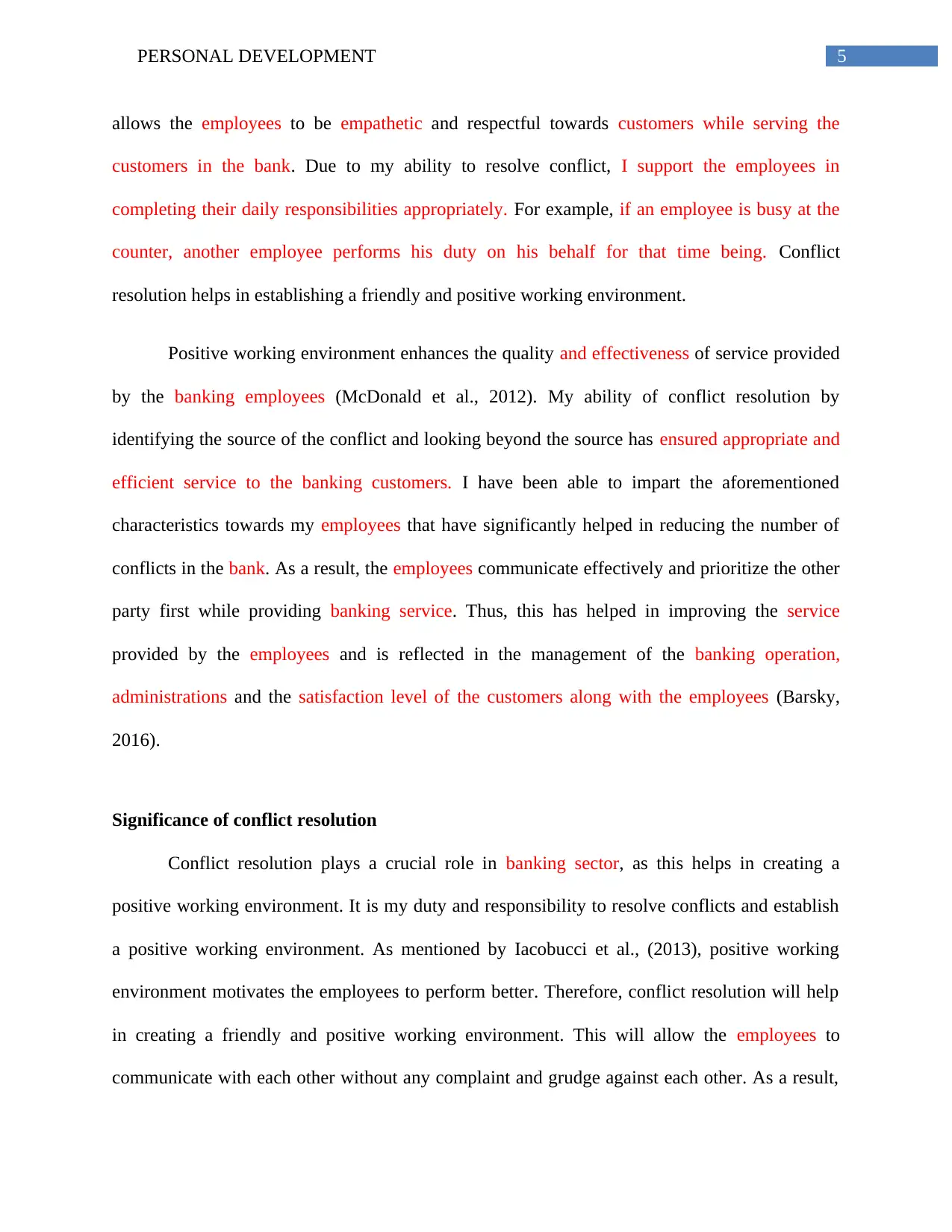
5PERSONAL DEVELOPMENT
allows the employees to be empathetic and respectful towards customers while serving the
customers in the bank. Due to my ability to resolve conflict, I support the employees in
completing their daily responsibilities appropriately. For example, if an employee is busy at the
counter, another employee performs his duty on his behalf for that time being. Conflict
resolution helps in establishing a friendly and positive working environment.
Positive working environment enhances the quality and effectiveness of service provided
by the banking employees (McDonald et al., 2012). My ability of conflict resolution by
identifying the source of the conflict and looking beyond the source has ensured appropriate and
efficient service to the banking customers. I have been able to impart the aforementioned
characteristics towards my employees that have significantly helped in reducing the number of
conflicts in the bank. As a result, the employees communicate effectively and prioritize the other
party first while providing banking service. Thus, this has helped in improving the service
provided by the employees and is reflected in the management of the banking operation,
administrations and the satisfaction level of the customers along with the employees (Barsky,
2016).
Significance of conflict resolution
Conflict resolution plays a crucial role in banking sector, as this helps in creating a
positive working environment. It is my duty and responsibility to resolve conflicts and establish
a positive working environment. As mentioned by Iacobucci et al., (2013), positive working
environment motivates the employees to perform better. Therefore, conflict resolution will help
in creating a friendly and positive working environment. This will allow the employees to
communicate with each other without any complaint and grudge against each other. As a result,
allows the employees to be empathetic and respectful towards customers while serving the
customers in the bank. Due to my ability to resolve conflict, I support the employees in
completing their daily responsibilities appropriately. For example, if an employee is busy at the
counter, another employee performs his duty on his behalf for that time being. Conflict
resolution helps in establishing a friendly and positive working environment.
Positive working environment enhances the quality and effectiveness of service provided
by the banking employees (McDonald et al., 2012). My ability of conflict resolution by
identifying the source of the conflict and looking beyond the source has ensured appropriate and
efficient service to the banking customers. I have been able to impart the aforementioned
characteristics towards my employees that have significantly helped in reducing the number of
conflicts in the bank. As a result, the employees communicate effectively and prioritize the other
party first while providing banking service. Thus, this has helped in improving the service
provided by the employees and is reflected in the management of the banking operation,
administrations and the satisfaction level of the customers along with the employees (Barsky,
2016).
Significance of conflict resolution
Conflict resolution plays a crucial role in banking sector, as this helps in creating a
positive working environment. It is my duty and responsibility to resolve conflicts and establish
a positive working environment. As mentioned by Iacobucci et al., (2013), positive working
environment motivates the employees to perform better. Therefore, conflict resolution will help
in creating a friendly and positive working environment. This will allow the employees to
communicate with each other without any complaint and grudge against each other. As a result,
⊘ This is a preview!⊘
Do you want full access?
Subscribe today to unlock all pages.

Trusted by 1+ million students worldwide
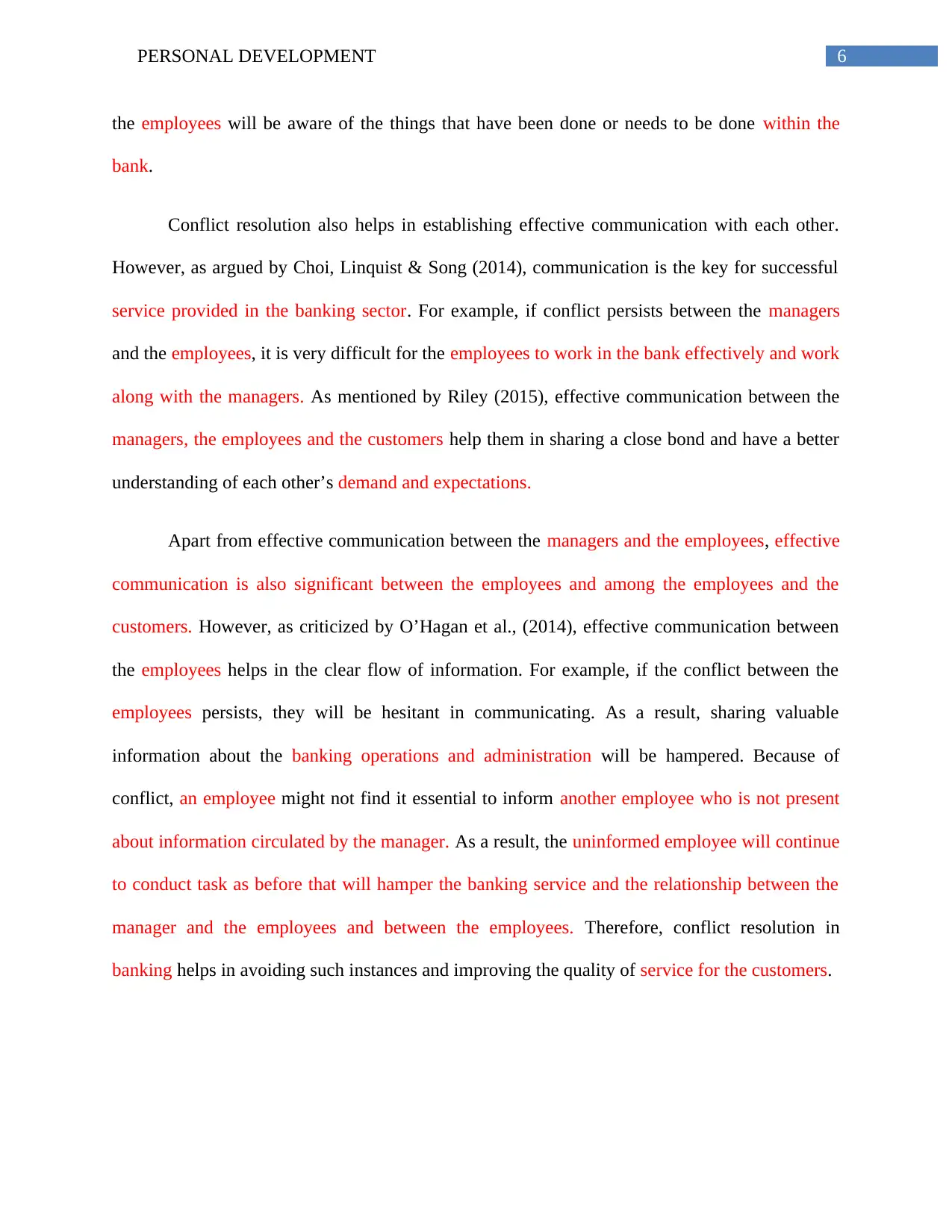
6PERSONAL DEVELOPMENT
the employees will be aware of the things that have been done or needs to be done within the
bank.
Conflict resolution also helps in establishing effective communication with each other.
However, as argued by Choi, Linquist & Song (2014), communication is the key for successful
service provided in the banking sector. For example, if conflict persists between the managers
and the employees, it is very difficult for the employees to work in the bank effectively and work
along with the managers. As mentioned by Riley (2015), effective communication between the
managers, the employees and the customers help them in sharing a close bond and have a better
understanding of each other’s demand and expectations.
Apart from effective communication between the managers and the employees, effective
communication is also significant between the employees and among the employees and the
customers. However, as criticized by O’Hagan et al., (2014), effective communication between
the employees helps in the clear flow of information. For example, if the conflict between the
employees persists, they will be hesitant in communicating. As a result, sharing valuable
information about the banking operations and administration will be hampered. Because of
conflict, an employee might not find it essential to inform another employee who is not present
about information circulated by the manager. As a result, the uninformed employee will continue
to conduct task as before that will hamper the banking service and the relationship between the
manager and the employees and between the employees. Therefore, conflict resolution in
banking helps in avoiding such instances and improving the quality of service for the customers.
the employees will be aware of the things that have been done or needs to be done within the
bank.
Conflict resolution also helps in establishing effective communication with each other.
However, as argued by Choi, Linquist & Song (2014), communication is the key for successful
service provided in the banking sector. For example, if conflict persists between the managers
and the employees, it is very difficult for the employees to work in the bank effectively and work
along with the managers. As mentioned by Riley (2015), effective communication between the
managers, the employees and the customers help them in sharing a close bond and have a better
understanding of each other’s demand and expectations.
Apart from effective communication between the managers and the employees, effective
communication is also significant between the employees and among the employees and the
customers. However, as criticized by O’Hagan et al., (2014), effective communication between
the employees helps in the clear flow of information. For example, if the conflict between the
employees persists, they will be hesitant in communicating. As a result, sharing valuable
information about the banking operations and administration will be hampered. Because of
conflict, an employee might not find it essential to inform another employee who is not present
about information circulated by the manager. As a result, the uninformed employee will continue
to conduct task as before that will hamper the banking service and the relationship between the
manager and the employees and between the employees. Therefore, conflict resolution in
banking helps in avoiding such instances and improving the quality of service for the customers.
Paraphrase This Document
Need a fresh take? Get an instant paraphrase of this document with our AI Paraphraser
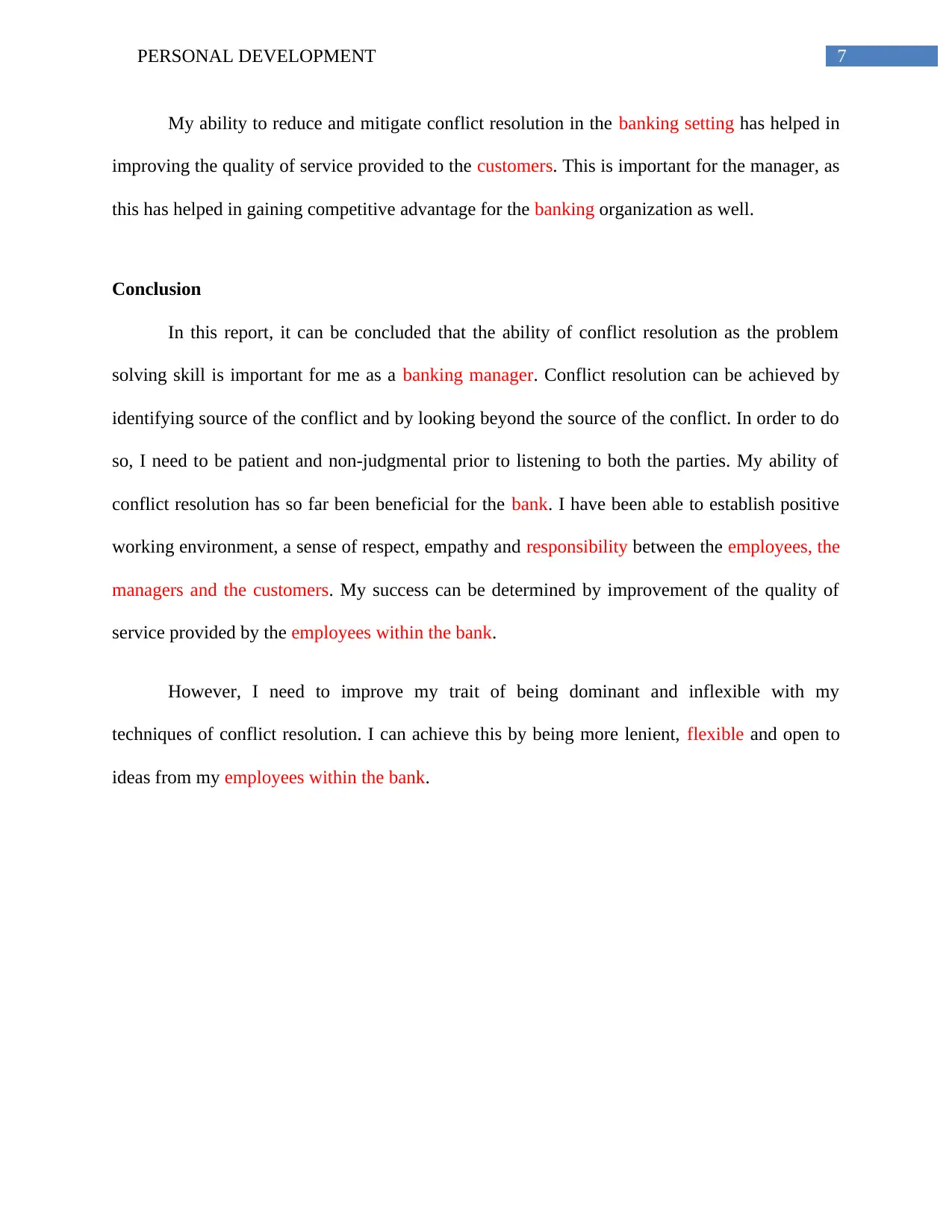
7PERSONAL DEVELOPMENT
My ability to reduce and mitigate conflict resolution in the banking setting has helped in
improving the quality of service provided to the customers. This is important for the manager, as
this has helped in gaining competitive advantage for the banking organization as well.
Conclusion
In this report, it can be concluded that the ability of conflict resolution as the problem
solving skill is important for me as a banking manager. Conflict resolution can be achieved by
identifying source of the conflict and by looking beyond the source of the conflict. In order to do
so, I need to be patient and non-judgmental prior to listening to both the parties. My ability of
conflict resolution has so far been beneficial for the bank. I have been able to establish positive
working environment, a sense of respect, empathy and responsibility between the employees, the
managers and the customers. My success can be determined by improvement of the quality of
service provided by the employees within the bank.
However, I need to improve my trait of being dominant and inflexible with my
techniques of conflict resolution. I can achieve this by being more lenient, flexible and open to
ideas from my employees within the bank.
My ability to reduce and mitigate conflict resolution in the banking setting has helped in
improving the quality of service provided to the customers. This is important for the manager, as
this has helped in gaining competitive advantage for the banking organization as well.
Conclusion
In this report, it can be concluded that the ability of conflict resolution as the problem
solving skill is important for me as a banking manager. Conflict resolution can be achieved by
identifying source of the conflict and by looking beyond the source of the conflict. In order to do
so, I need to be patient and non-judgmental prior to listening to both the parties. My ability of
conflict resolution has so far been beneficial for the bank. I have been able to establish positive
working environment, a sense of respect, empathy and responsibility between the employees, the
managers and the customers. My success can be determined by improvement of the quality of
service provided by the employees within the bank.
However, I need to improve my trait of being dominant and inflexible with my
techniques of conflict resolution. I can achieve this by being more lenient, flexible and open to
ideas from my employees within the bank.
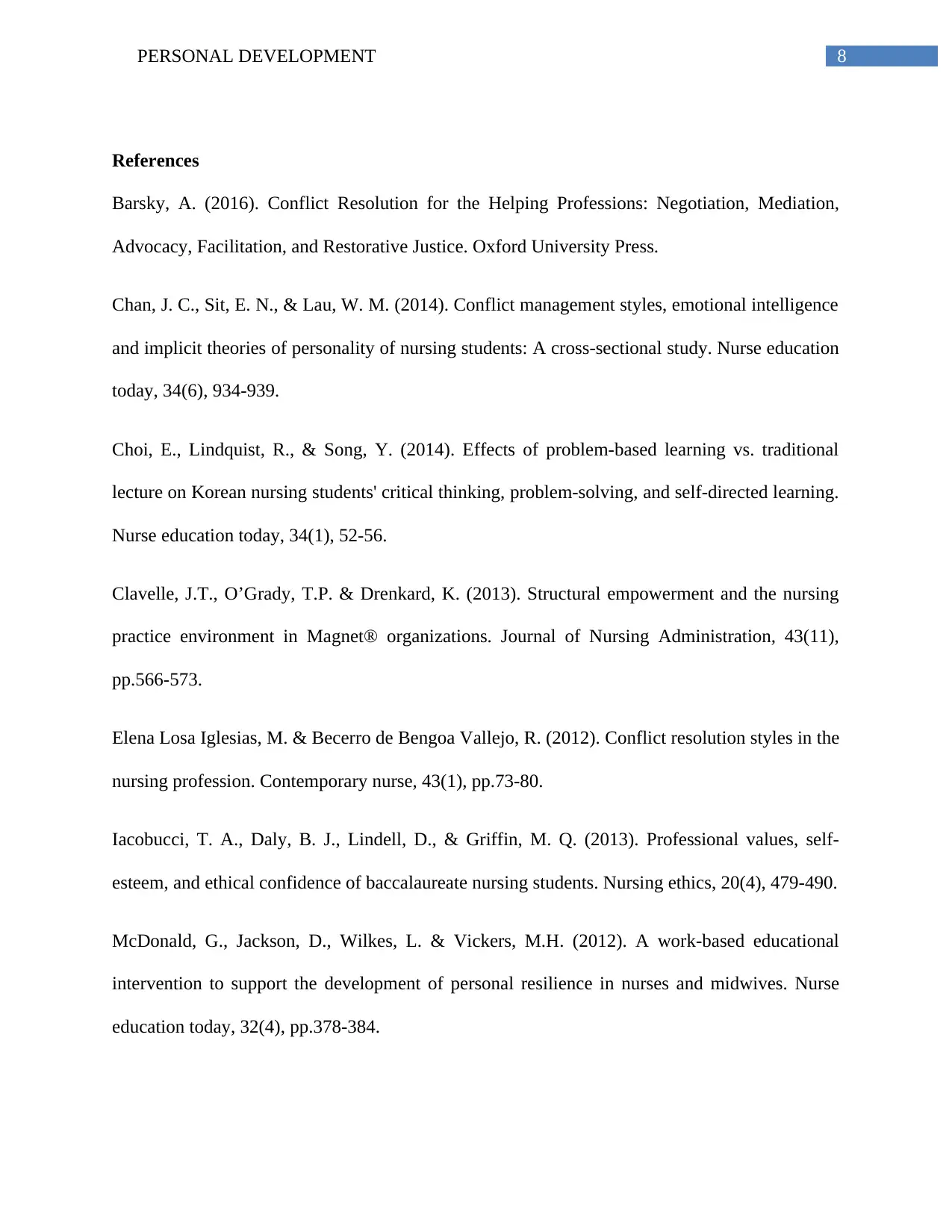
8PERSONAL DEVELOPMENT
References
Barsky, A. (2016). Conflict Resolution for the Helping Professions: Negotiation, Mediation,
Advocacy, Facilitation, and Restorative Justice. Oxford University Press.
Chan, J. C., Sit, E. N., & Lau, W. M. (2014). Conflict management styles, emotional intelligence
and implicit theories of personality of nursing students: A cross-sectional study. Nurse education
today, 34(6), 934-939.
Choi, E., Lindquist, R., & Song, Y. (2014). Effects of problem-based learning vs. traditional
lecture on Korean nursing students' critical thinking, problem-solving, and self-directed learning.
Nurse education today, 34(1), 52-56.
Clavelle, J.T., O’Grady, T.P. & Drenkard, K. (2013). Structural empowerment and the nursing
practice environment in Magnet® organizations. Journal of Nursing Administration, 43(11),
pp.566-573.
Elena Losa Iglesias, M. & Becerro de Bengoa Vallejo, R. (2012). Conflict resolution styles in the
nursing profession. Contemporary nurse, 43(1), pp.73-80.
Iacobucci, T. A., Daly, B. J., Lindell, D., & Griffin, M. Q. (2013). Professional values, self-
esteem, and ethical confidence of baccalaureate nursing students. Nursing ethics, 20(4), 479-490.
McDonald, G., Jackson, D., Wilkes, L. & Vickers, M.H. (2012). A work-based educational
intervention to support the development of personal resilience in nurses and midwives. Nurse
education today, 32(4), pp.378-384.
References
Barsky, A. (2016). Conflict Resolution for the Helping Professions: Negotiation, Mediation,
Advocacy, Facilitation, and Restorative Justice. Oxford University Press.
Chan, J. C., Sit, E. N., & Lau, W. M. (2014). Conflict management styles, emotional intelligence
and implicit theories of personality of nursing students: A cross-sectional study. Nurse education
today, 34(6), 934-939.
Choi, E., Lindquist, R., & Song, Y. (2014). Effects of problem-based learning vs. traditional
lecture on Korean nursing students' critical thinking, problem-solving, and self-directed learning.
Nurse education today, 34(1), 52-56.
Clavelle, J.T., O’Grady, T.P. & Drenkard, K. (2013). Structural empowerment and the nursing
practice environment in Magnet® organizations. Journal of Nursing Administration, 43(11),
pp.566-573.
Elena Losa Iglesias, M. & Becerro de Bengoa Vallejo, R. (2012). Conflict resolution styles in the
nursing profession. Contemporary nurse, 43(1), pp.73-80.
Iacobucci, T. A., Daly, B. J., Lindell, D., & Griffin, M. Q. (2013). Professional values, self-
esteem, and ethical confidence of baccalaureate nursing students. Nursing ethics, 20(4), 479-490.
McDonald, G., Jackson, D., Wilkes, L. & Vickers, M.H. (2012). A work-based educational
intervention to support the development of personal resilience in nurses and midwives. Nurse
education today, 32(4), pp.378-384.
⊘ This is a preview!⊘
Do you want full access?
Subscribe today to unlock all pages.

Trusted by 1+ million students worldwide
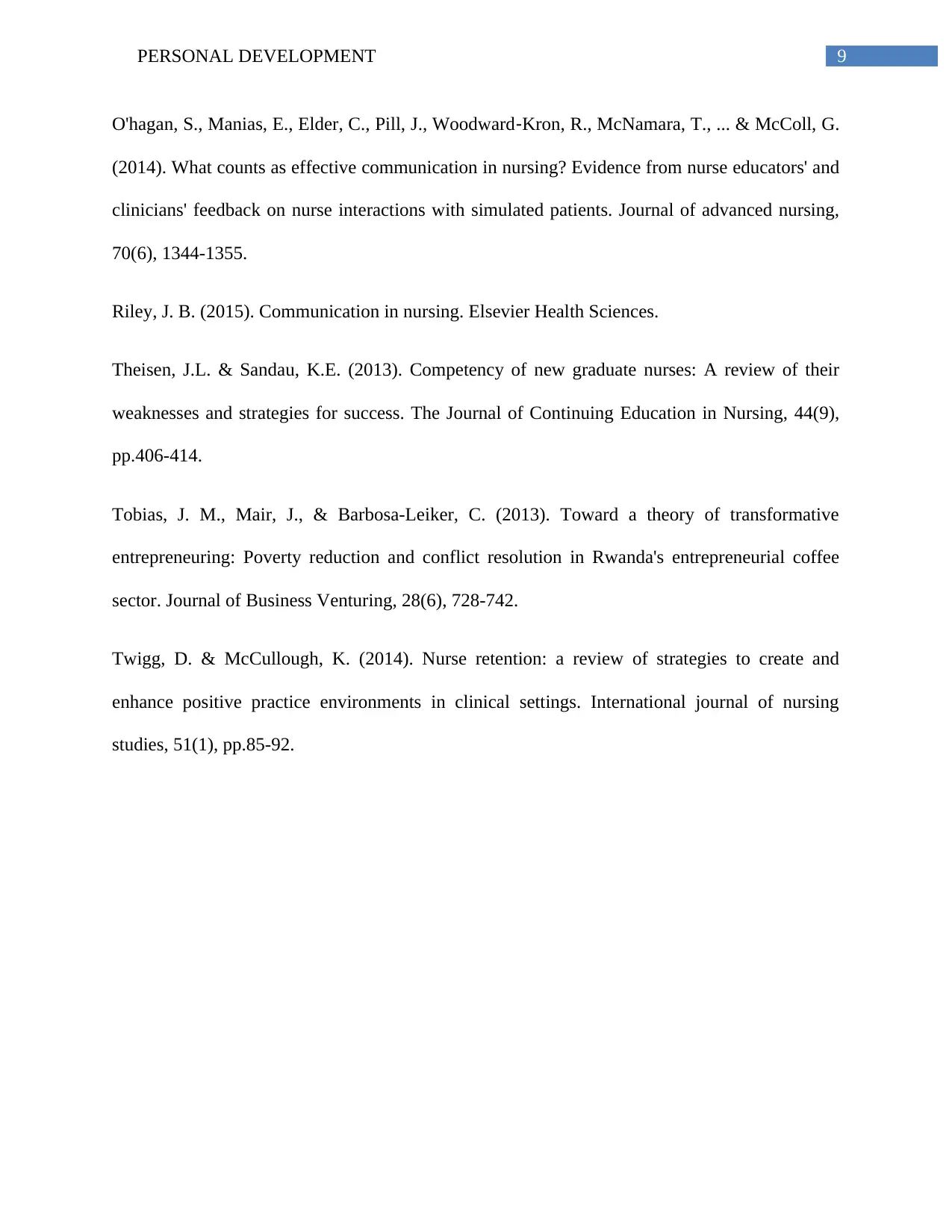
9PERSONAL DEVELOPMENT
O'hagan, S., Manias, E., Elder, C., Pill, J., Woodward‐Kron, R., McNamara, T., ... & McColl, G.
(2014). What counts as effective communication in nursing? Evidence from nurse educators' and
clinicians' feedback on nurse interactions with simulated patients. Journal of advanced nursing,
70(6), 1344-1355.
Riley, J. B. (2015). Communication in nursing. Elsevier Health Sciences.
Theisen, J.L. & Sandau, K.E. (2013). Competency of new graduate nurses: A review of their
weaknesses and strategies for success. The Journal of Continuing Education in Nursing, 44(9),
pp.406-414.
Tobias, J. M., Mair, J., & Barbosa-Leiker, C. (2013). Toward a theory of transformative
entrepreneuring: Poverty reduction and conflict resolution in Rwanda's entrepreneurial coffee
sector. Journal of Business Venturing, 28(6), 728-742.
Twigg, D. & McCullough, K. (2014). Nurse retention: a review of strategies to create and
enhance positive practice environments in clinical settings. International journal of nursing
studies, 51(1), pp.85-92.
O'hagan, S., Manias, E., Elder, C., Pill, J., Woodward‐Kron, R., McNamara, T., ... & McColl, G.
(2014). What counts as effective communication in nursing? Evidence from nurse educators' and
clinicians' feedback on nurse interactions with simulated patients. Journal of advanced nursing,
70(6), 1344-1355.
Riley, J. B. (2015). Communication in nursing. Elsevier Health Sciences.
Theisen, J.L. & Sandau, K.E. (2013). Competency of new graduate nurses: A review of their
weaknesses and strategies for success. The Journal of Continuing Education in Nursing, 44(9),
pp.406-414.
Tobias, J. M., Mair, J., & Barbosa-Leiker, C. (2013). Toward a theory of transformative
entrepreneuring: Poverty reduction and conflict resolution in Rwanda's entrepreneurial coffee
sector. Journal of Business Venturing, 28(6), 728-742.
Twigg, D. & McCullough, K. (2014). Nurse retention: a review of strategies to create and
enhance positive practice environments in clinical settings. International journal of nursing
studies, 51(1), pp.85-92.
1 out of 10
Related Documents
Your All-in-One AI-Powered Toolkit for Academic Success.
+13062052269
info@desklib.com
Available 24*7 on WhatsApp / Email
![[object Object]](/_next/static/media/star-bottom.7253800d.svg)
Unlock your academic potential
Copyright © 2020–2025 A2Z Services. All Rights Reserved. Developed and managed by ZUCOL.





